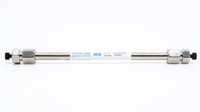Amino Acid Analysis

Concise Separation Columns for Amino Acid Analysis
- Robust polymeric resin stable across the full pH range of 0 to 14
- High efficiency and strong resolution for complex amino acid mixtures
- Excellent lot-to-lot and column-to-column reproducibility
- Available in Li+ form for physiological samples and Na+ form for protein hydrolysates
- Optimized for post-column derivatization detection workflows
Concise Separations amino acid columns are engineered specifically for ion-exchange chromatography (IEC), the gold-standard technique for amino acid analysis due to its unmatched reproducibility. IEC delivers stable retention times and accurate quantitation regardless of sample matrix, making it ideal for clinical diagnostics, nutritional research, protein hydrolysate analysis, and quality control applications.
Amino acids naturally exist as zwitterions. Under low-pH conditions, they carry a net positive charge and bind strongly to negatively charged ion-exchange sites on the polymeric resin, while most matrix components elute in the void volume. Selective elution is achieved by gradually increasing pH and salt concentration, causing amino acids to dissociate from the stationary phase in a highly predictable manner.
The elution order generally follows the amino acids’ isoelectric points—acidic species elute first, followed by neutral and basic. Because the separation and subsequent post-column derivatization occur free from interfering contaminants, ion-exchange methods using Concise Separations columns consistently produce highly reproducible chromatograms suitable for precise quantitative analysis.

